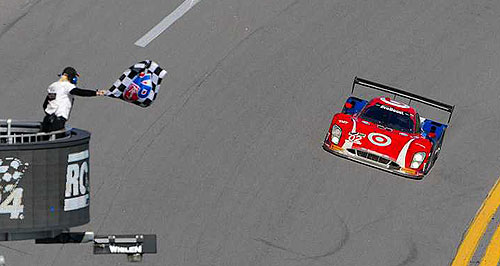Make / Model Search
News - FordFord uses 3D printing to win racesTesta nero: Ford's 3D-printed inlet manifold is complemented by carbon-fibre plenum chambers and feeds air to a Roush-Yates developed EcoBoost 3.5-litre V6 with race-winning reliability. Three dimensional printing creates parts for Ford prototypes and racers29 May 2015 A HIGHLY strung Ford V6 race engine that uses 3D printed parts has pushed a Ford EcoBoost Riley Daytona Prototype to victory at the 53rd 24 Hours of Daytona in the United States, proving the durability of components manufactured using the emerging technology. The EcoBoost engine's inlet manifold was designed and manufactured just days before the race, but such is the speed of the 'printing' process that another could technically be made before the American endurance race was complete. Ford has previously used the 3D printing process to produce one-off components for prototype and test engines, but the iconic race win demonstrates the ability of parts to withstand the punishment of a grueling endurance race. Not only did the manifold prove its durability over 24 hours of racing, its new less restrictive design increased the twin-turbo Ford V6 power, and weighs less than the more conventionally manufactured part. Originally, the manufacturing process was used to make simple control knobs and buttons, but with significant advances in the technology, Ford is experimenting with more complex components. When mounted atop the Roush-Yates developed 3.5-litre EcoBoost V6, the manifold must withstand searing temperatures and high internal pressures, produced by the pair of turbos. Like many technologies conceived by motorsport, the 3D printing advances are filtering down to more terrestrial road-car applications, and the versatility of 3D printing is enabling Ford to produce higher quality products on both a component and grander scale. The car-maker has no plans to mass produce 3D printed parts for retail or series production, but the reduction of design-to-test time is allowing engineers to develop new technology, including engines, faster than ever before. The 3.5-litre EcoBoost race engine engineer Victor Martinez said cutting lead times was critical for the development of modern vehicles both on the road and circuit. “3D printing has advanced at such lightning speed in recent years that in a matter of hours, we can create real, usable parts for race cars,” he said. “That’s exactly what we did for the 24 Hours of Daytona earlier this year.”“We have the ability to design an entirely new part and, one week later, have that part in hand. This lets the engineers who develop our cars – both for road and track – spend more time testing, tuning and refining.” Ford's victory at Daytona is the first enabled by 3D printed components, but the process is by no means new to the automotive industry. Swedish “megacar” maker Koenigsegg employed the process in the creation of its barmy One:1 coupe, to produce its pair of turbos – components requiring extraordinary precision. The Team Chip Ganassi's victorious Ford heads back to the track this weekend, where it will compete in the Belle Isle round of the Tudor United Sportscar competition.  Read more |
Click to shareFord articlesResearch Ford Motor industry news |












Facebook Twitter Instagram